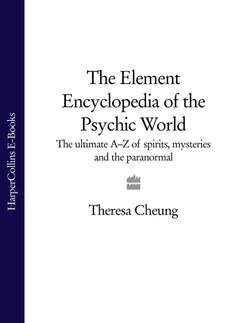Читать книгу The Element Encyclopedia of the Psychic World: The Ultimate A–Z of Spirits, Mysteries and the Paranormal - Theresa Cheung, Theresa Cheung - Страница 64
ASH MANOR GHOST
ОглавлениеPsychical researcher Nandor Fodor solved the mystery of the Ash Manor ghost in 1930s England. The case was one of his most famous and helped to establish his theory of the psychological underpinning of some hauntings. He recorded the case in detail in his book The Haunted Mind (1959). Mr and Mrs Keel (a pseudonym assigned by Fodor) moved into Ash Manor House in Sussex, England, with their 16-year-old daughter and servants on 24 June 1934. They were aware that parts of the house dated back to the thirteenth century and that it had a reputation for being haunted. It wasn’t long before the daughter and servants reported strange noises coming from the attic, and Mr and Mrs Keel heard strange bangs on their bedroom doors.
The Keels suspected something supernatural was afoot, and on 23 November Mr Keel woke to see ‘a little oldish man, dressed in a green smock, very muddy breeches and gaiters, a slouch hat on his head and a handkerchief around his neck’. Keel tried to grab the man, thinking him a servant, but was astonished to see his hand go right through him. Keel ran to his wife, who also saw the man and tried to strike him, but her fist went through him too. The strange noises continued, and the green man, as the Keels called him, continued to appear. Once the phantom raised his head, and Mrs Keel could see that his neck had been cut all the way around. She concluded that he must have been murdered and that perhaps his skeleton was hidden in the house.
The manifestations were so frightening that the servants quit their jobs. The Keels were advised to get help in exorcizing the ghost by advertising in a newspaper. Several individuals tried to do the job but did not succeed.
In July 1936 Fodor was invited to investigate the case by a writer who was including the Ash Manor ghost in his book about hauntings. Fodor arrived and saw that the Keels were fearful of any harm being done to their reputations by the publicity. He stayed in the house for several nights, but no manifestations occurred.
At that time the medium Eileen Garrett was living in England, and Fodor asked her to visit Ash Manor. Garrett arrived on 25 July and immediately received the clairvoyant impression of a man who had been half brother to Edward IV or V and had started a rebellion. He had been tortured and left crippled as a result. That evening Garrett entered the haunted house and went into a trance, and her control, Uvani, spoke. Uvani explained that ghosts often manifest when an atmosphere of unhappiness enables a spirit to draw energy and revive its suffering. ‘Haven’t you discovered that these things only happen to you when you are in a bad emotional state, physically or mentally disturbed?’ Uvani asked. The control went on to say that in the fifteenth century a jail had existed near the house, where many unhappy souls had lost their lives. Anyone living in the house who was ‘nervously depleted’ would give out energy that would attract a ghost, who would use that energy to build himself up, like a ‘picture on the stage’.
Uvani permitted the ghost to possess Garrett, and the Keels said that her features looked like those of the green man. Speaking through Garrett, the ghost announced, in a medieval English accent, that he was called Charles Edward. He claimed to have been robbed of his lands by the Earl of Huntingdon and betrayed by a friend called Buckingham. He asked the witnesses to help him wreak revenge upon his enemies. Fodor informed the ghost that he was dead and begged him to give up his quest and join the spirits of his loved ones. The ghost reluctantly agreed to do so, and Garrett returned to normal consciousness.
The hauntings, however, did not stop, and Fodor conducted another session with Garrett, this time without the Keels present. The ghost once again appeared and pleaded for help in getting vengeance. Uvani announced that the Keels had used this ‘poor, unhappy creature’ in order to embarrass each other and that they did not want the ghost to leave. The control also said that if the unhappiness in the house persisted, it would become truly haunted.
Fodor at last felt that he was close to solving the case. Mrs Keel confessed to him that her husband was homosexual and that a great deal of tension existed between them. Fodor suggested that the ghost provided a distraction that prevented that tension from breaking out into the open.
When the Keels admitted they were hanging on to the ghost, the ghost departed. A scholarly investigation of the statements made by Charles Edward deemed they were not authentic, and Fodor, in analysing the case, considered the ghost to be an invention of Mr Keel’s subconscious mind, which Garrett had tapped into.
However, some of the haunting phenomena at Ash Manor could not be explained, for example, the independent sightings by servants and other witnesses. Fodor concluded that ‘it may be that those who put themselves in an unguarded psychological position, in a place filled with historical memories and traditions, do, on rare occasions, come into contact with a force or an intelligence other than their own.’
